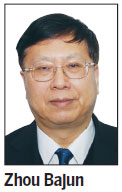NED donation is proof of a 'color revolution'
Updated: 2014-10-20 07:10
By Zhou Bajun(HK Edition)
|
|||||||
What is "color revolution"? Is it a joke when the Western media call the "Occupy Central" movement in Hong Kong an "Umbrella Revolution"?
Examine the slogans, activities and funding of "Occupy" and you will find the answer is that "Occupy" is a "color revolution" with Hong Kong characteristics.
A "color revolution" has four main characteristics: First, it's a sociopolitical movement which generally adopts a color or flower as its symbol. "Occupy" in Hong Kong is symbolized by the "umbrella" because most "Occupy" activists in the streets wave colorful umbrellas against the police.
Second, it's a type of civil resistance and breach of local laws. In Hong Kong, the "Occupy" organizers have declared it to be a "civil disobedience" campaign from the start.
Third, participants in color revolutions mostly use devices such as demonstrations and strikes to protest against government and advocate Western-style democracy. They also generate strong public pressure for change. Here in Hong Kong, the opposition has used "Occupy" to compel the central government to accept "genuine universal suffrage". The street "occupiers" want the National People's Congress Standing Committee (NPCSC) to withdraw its Aug 31 decision.

Fourth, local non-governmental organizations (NGOs) - particularly student organizations - have played a significant role in organizing "civil disobedience" campaigns. This is also true of Hong Kong's "Occupy" movement. Local NGOs here have received funds from foreign NGOs purportedly controlled by foreign governments. The NGOs in the opposition camp are enjoying strong foreign support.
Documents recently released by informed sources show opposition lawmaker Lee Cheuk-yan, head of the Hong Kong Confederation of Trade Unions, received funds from an American organization to finance the "Occupy" campaign. It has been reported that since 1993, Lee received around $1.64 million (nearly HK$13 million) from American Center for International Labor Solidarity which is believed to have received funding from the US National Endowment for Democracy (NED). According to these documents, including agreements and receipts, some of the funding proposals mention the illegal "Occupy" campaign.
That Lee has been receiving donations from this US organization for more than 20 years clearly indicates he is an instrument of outside forces. It was revealed three months ago that Lee received two sums totaling HK$1.5 million from Next Media Chairman Jimmy Lai Chee-ying. The media tycoon also reportedly has close connections with overseas groups. Moreover, another four lawmakers from the opposition camp also reportedly received political donations from Lai. This is further evidence of a strong connection between the city's opposition camp and US political organizations.
Some Hongkongers disagree with the notion that the "Occupy Central" campaign is a "color revolution". They argue that the city's opposition is incapable of toppling the central government. But the four characteristics of the campaign mentioned above prove the "Occupy" action is a typical "color revolution".
It was obvious that the opposition camp has consistently opposed central government authority when they shouted: "End the one-party regime". For this purpose they obstructed Hong Kong from enacting local national security laws in accordance with Article 23 of the Basic Law in 2003 and fought the local national education plans in 2012, and this paved the way for demanding so-called "genuine universal suffrage".
No doubt, the opposition camp still enjoys the edge in the political battles raging in the city. For example, opposition lawmakers hold the power of veto in the Legislative Council (LegCo). The "pan-democrats" command strong support in the legal and educational sectors. But despite this, the "Occupy" campaign is doomed to fail as its members merely account for a tiny percentage of the city's population.
When Western media describe political movements around the world as "color revolutions" they argue that protesters are standing on the right side of history. They hold the same belief for the "Occupy " movement. But patriots in Hong Kong hold a different view when they call "Occupy" a "color revolution".
In this column I have reiterated that the HKSAR's constitutional development must strictly follow the Basic Law and relevant decisions by the NPCSC. Under the constitutional framework of "One Country, Two Systems", the Chief Executive and LegCo members are obligated to ensure the HKSAR Government obeys the central authorities. Therefore, it's the "Love Nation and Love Hong Kong" camp - not the opposition - that stands on the right side of history.
The author is a veteran current affairs commentator.
(HK Edition 10/20/2014 page9)